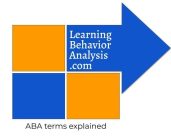B-10: Define and provide examples of stimulus control ©
Want this as a downloadable PDF? Click here!
Target Term: Stimulus Control
Stimulus Control
Definition: Rates of responding happen exclusively, or at a higher rate, in the presence of a stimulus rather than in its absence.
Example in everyday context: You stop your car when you have arrived at your destination, as well as at red lights and stop signs, at crosswalks in the presence of pedestrians, and at yield signs when other vehicles are present. You do not stop your car at random points during your drive on the freeway. Your car braking behavior is under the control of specific stimuli.
Example in clinical context: A client says “Hi!” when staff members prompt her by saying, “Say hi!” The client does not ever initiate greetings without this prompt. The client’s behavior of saying hi is under the control of the staff’s directive prompt. (This is a problem! For a greeting behavior to have social significance, it typically needs to be under the control of at least one of the following: (1) a person coming into the environment, and (2) a person stating a greeting, which can then be returned).
Example in supervision/consultation context: A teacher engages in high rates of behavior specific praise statements when the behavior analysts consultant is in the room. The teacher uses few praise statements when the consultant is not there.
Why it matters: Understanding the environmental variables controlling both interfering and adaptive behavior is very important when designing clinical programming. It is particularly applicable when considering how to teach independence and how to use prompting strategies.
